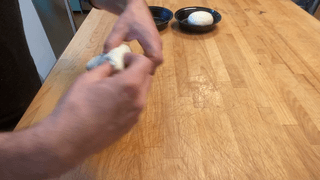Recipe: NYC Thin-Crust Pizza Dough
Famous original

Table of Contents
Before I share the third and final part of my epic thin-crust pizza guide—on oven setup and baking—I figured I’d send out a dough recipe, since it’ll need at least a day in the fridge before you can bake with it. That way once the baking post drops, you’ll be ready to jump right in if you want. Today’s recipe is for a yeasted pie; expect a sourdough thin-crust recipe next week.

I grew up—and live—in the Boston area, where we are not known for our pizza joints. (In Massachusetts, pizza generally means Greek pizza. Though Greek pizza definitely can be good it is, alas, usually pretty lackluster.) But I lived in New York City for 7 years, and I like to think I know my way around an NYC slice. Much of this will be familiar from my previous two posts, but here’s what I look for in one: A slice that is—aside from the puffy handlebar—evenly flat from edge to edge, with a crisp-chewy, nicely-browned exterior crust, and a moist, tender-chewy interior crumb. As far as sauce and cheese go, a lightly sweetened, cooked tomato sauce (stay tuned for a recipe on Thursday) topped with stringy, stretchy low-moisture aged mozzarella cheese.
Here’s a breakdown of the formula, in baker’s percentages:
- 100% high-gluten or bread flour: For the proper amount of crisp-chewy/tender-chewy texture, I want a lot of gluten-forming protein. This means using either a high-gluten flour like King Arthur’s Sir Lancelot (14.2% protein)—not generally sold in supermarkets, but available online, and worth the effort to get—or bread flour (12.7% protein), plus:
- 1.5% vital wheat gluten (if using bread flour): Vital wheat gluten—something you can find at most supermarkets—is essentially pure gluten. The general rule is that the gluten content of a flour increases linearly with the amount you add; in other words, each additional 1% VWG increases the effective gluten content of the flour by 1%. But in my experience there’s a limit to VWG’s effectiveness. Use too much and the dough can turn tough, so I never add more than 1.5%. (For example, when re-testing this recipe recently, I tried “converting” 11.7% protein King Arthur all-purpose flour into high-gluten flour by adding 2.5% VWG, but pizza made with it was tough.)
- 1% diastatic malt powder: Enzymatically-active diastatic malt ensures that there are sugars remaining in a dough for proper browning, even after a long fermentation.
- 0.23% instant yeast: In long, cold fermentations, the goal is a gentle fermentation for flavor rather than carbon dioxide. This is about one-quarter the minimum amount typically used in a room-temperature fermented bread.
- 66% ice-cold water: I explain why I use ice water in the dough below. As for the amount of water, this is a medium-hydration dough, tailored to crisp up quickly in a home oven while remaining moist on the inside.
- 2% oil: Oil tenderizes the dough. At such small percentages it lends no perceptible flavor to the dough, so it’s not necessary to use olive oil (though there’s no reason not to either).
- 2.2% salt: This is on the high side for breads—normally I use 1.5-2% salt in most formulas. But pizza just tastes better with extra salt.
Process
I tend to make this dough in a food processor, since it’s quick, easy, and ideally sized for one, but it can also be made in a stand mixer as well. Food processors are actually excellent at mixing doughs, as long as you use the metal blade. Gluten development during mixing is the result of disordered gluten strands being combined, broken apart, and recombined repeatedly until a more ordered network forms. A sharp metal blade is a very efficient way to do this, since it slices up the developing gluten strands with minimal effort. (In a stand mixer, the same effect occurs via stretching of the strands until they tear apart. The plastic “dough” blades that come with every food processor are virtually useless, because they do little other than clumsily push the ball of dough around the bowl.) A food processor’s high RPMs mean that something that might take 8-12 minutes in a stand mixer only takes a few minutes in one.
If you want to double the recipe to make four 12-inch pies, then it’ll have to be made in a stand mixer. (I haven't yet sorted out a good way to make this dough by hand, since that would require a few sets of folds during the first few hours of bulk fermentation. You could probably keep the dough in the fridge to keep it cold and pull it out periodically to perform the folds.)
Autolyse
This recipe incorporates a 10-15 minute autolyse step prior to final mixing. If you aren’t already familiar with this technique, you will be soon enough, as it’s a favorite of mine and most other bakers. Here’s how I define an autolyse: the resting of a dough prior to the addition of salt and a preferment in order to promote the passive development of gluten and the rapid, complete hydration of the flour.
Here’s how it works:
- Water is needed to allow glutenin and gliadin—the two gluten-forming proteins found in wheat flour—to link up. (Fun fact: There is no gluten in flour, only the two gluten precursor proteins.)
- Once this happens, enzymes known as proteases snip newly-formed gluten strands into smaller pieces that can then recombine to form larger networks. (Enzymes require water to function as well.)
- Salt, meanwhile, is extremely hygroscopic, meaning it pulls water to itself like a magnet. (Think of what happens to shaker of salt on a humid day.) Leaving salt out of a dough during an autolyse therefore lets the flour absorb all the water it needs first.
- Salt also inhibits enzyme activity. Holding back salt during an autolyse allows proteases to function at maximum efficiency, promoting gluten development.
- Acids inhibit enzyme activity as well, which is why many recipes hold back the preferment until after the autolyse is complete. (That said, acids are much less inhibitory to enzymes than salt. Since preferments are often hard to incorporate into a dough late in the game, most of the time I just add my preferments at the start of mixing.)
- Many recipes also hold back yeast during an autolyse as well. Because acid production during fermentation takes time to ramp up, this is not necessary unless doing an extremely long room temperature autolyse.
Though most of the benefits of an autolyse can be achieved by simply mixing a dough for more time, there are good reasons to opt for the former. For one thing, an autolyse develops gluten without any of the friction produced by a machine, so doughs heat up far less. (This also means less wear and tear on the machine itself.) Also, holding back salt makes the hand mixing of doughs much easier, since it helps prevent those annoying pockets of dry flour that resist incorporation into the dough.
An effective autolyse can take as little as 10 minutes to complete, particularly when the dough is going to be mixed in a machine. For hand-mixed doughs, I tend to autolyse for at least 30 minutes, in order to maximize passive gluten development.
Ice Ice Baby
In order to avoid the creation of large alveoli in this dough, we want it to begin fermenting very gradually, which means it should be cool—below 65˚F or so—when mixing is complete, and it should go into the fridge as soon as the dough has been divided and shaped into balls.
In order to overcome the friction mixing creates, especially when using a food processor, you want the water in the dough to start out very cold. The good news is there’s no need to fuss with calculating desired dough temperature in this case, since you can just start with ice-cold water—anywhere between 32 and 38˚F is fine.
(This might seem self-evident, but: To make ice-cold water, combine water with a generous amount of ice and let it sit for at least a couple of minutes before straining off the remaining ice. Or just put a pitcher of water in the fridge for a few hours before using it.)
Baller
This dough is very easy to make, but there is one key step to pay attention to: shaping it into smooth balls. The trick is to fold the edges of the blob of dough up and over itself and then finish by pinching them all together to enclose the dough. It doesn’t need to be pretty, it only needs to be fully sealed—it’s better to have the dough sport a little tadpole-tail than to have it not enclosed.

Then place the dough, tail/seam-side down in a 5-inch wide takeout container, coat the top of the dough with oil, cover, and transfer to the fridge for the big sleep. (This dough is usable anytime within 24 to 96 hours, but I find it at the peak of flavor and texture at 72 hours.)
I’ll be back on Thursday with my oven and baking tips, see you all then.
—Andrew
NYC Thin-Crust Pizza Dough
Makes two 12-inch pies (375g each)
A gram scale accurate to 1g is preferable here, as the volume measures given are rounded to the nearest 1/4 teaspoon. High-gluten flour (e.g., King Arthur Sir Lancelot) or bread flour works best here; if using bread flour, the addition of vital wheat gluten will approximate the protein content of high-gluten flour. Diastatic malt powder is optional, but will help improve crust color and flavor and is highly recommended. It can be purchased online and it will keep for a long time if kept in a tightly-closed container; malt sugar or malt syrup are not suitable substitutes. Any type of vegetable oil will work here, including olive.
Overall formula:
100% high-gluten or bread flour
1.5% vital wheat gluten (if using bread flour)
1% diastatic malt powder
0.23% instant yeast
66% ice-cold water
2% oil
2.2% salt
Final mix:
430g high-gluten or bread flour
6g (2-1/4 teaspoons) vital wheat gluten (if using bread flour)
4g (1-1/4 teaspoons) diastatic malt powder
1g (1/4 teaspoon) instant yeast
285g ice-cold (32-38˚F) water
9g (2 teaspoons) oil
9g (1-3/4 teaspoons table) salt
- Place flour, diastatic malt, vital wheat gluten (if using bread flour), and yeast in bowl of food processor (or stand mixer fitted with dough hook) and pulse to combine. With machine running, add oil, followed by water in steady stream. Continue to process until dough is just mixed and no dry flour remains, 30 seconds to 1 minute (1 to 2 minutes in a stand mixer on medium speed). Allow to sit for 10 to 15 minutes (loosely covered if using a stand mixer).
- Add salt and process just until even ball forms (dough will remain slightly rough-textured), 30 to 60 seconds (6 to 8 minutes in a stand mixer at medium speed).
- Desired dough temperature: <65˚F
- Knead dough on lightly-oiled counter until smooth. Divide into two 375g portions and shape into tight, smooth balls (pinch seams thoroughly closed). Coat each ball lightly with oil, and transfer seam-side down to oil-coated containers (or a baking sheet sprayed with oil and covered tightly with plastic wrap).
- Bulk fermentation: Refrigerate for 24 to 96 hours.
- Remove containers from refrigerator and allow to sit until doughs are no longer chilled, about 1 hour at 75˚F.
- Preheat baking stone or steel at 500 to 550˚F.
- Coat each ball of dough generously with flour by dipping both sides in a bowl of flour and place on lightly-floured countertop, seam-side up. Using fingertips, gently flatten into 8-inch disk, leaving 1 inch of outer edge slightly thicker than center. Using hands, gently stretch disk into 11-inch round, working along edges and giving disk quarter turns as you stretch. Transfer dough to well-floured peel (or parchment paper on peel) and stretch into 12-inch round.
- Top as desired, leaving 1/4 inch of space around outer edge of pizza.
- Bake until crust is well-browned and cheese is bubbly and beginning to brown, 6 to 12 minutes.
- Repeat with remaining ball of dough.
wordloaf Newsletter
Join the newsletter to receive the latest updates in your inbox.




